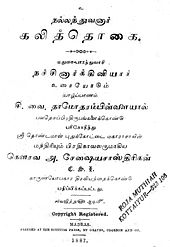Kalittogai
| Sangam literature |
|---|
|
Ettuttogai ("eight anthologies") |
|
Pattuppattu ("ten chants") |
The Kalittogai ( Tamil : கலித்தொகை Kalittokai [ ˈkalit̪ːoɦɛi̯ ] "collection in the Kali measure") is a work of the ancient Tamil Sangam literature . It is an anthology of 150 love poems. The Kalottogai is one of the later works of Sangam literature and belongs to the group of the "eight anthologies" ( Ettuttogai ).
Formal aspects
Of the two genres of Sangam literature (love and hero poetry), the Kalittogai represents the genre of love poetry ( agam ). The 150 poems of Kurundogai are written in the eponymous Kali measure and have a length of 11 to 80 lines. The first poem is an introductory verse with an invocation of the Lord Shiva . For Kalittogai exists a detailed commentary of the author Nachinarkkiniyar from the 14th century.
The Kalittogai is divided into five sections of different lengths. The subdivision follows the old Tamil concept of the five tinais - love situations, each associated with a certain type of landscape. The first section takes place in the desert ( palai ), the second in the mountain landscape ( kurinchi ), the third in arable land ( marutam ), the fourth in pastureland ( mullai ) and the fifth on the coast ( neydal ). Each of the five sections is traditionally attributed to a single poet, namely Perungadungon (desert), Kabilar (mountains), Marudanilangan (farmland), Cholan Nalluttiran (pastureland) and Nallanduvanar (coast). The attribution of the authors is doubtful for chronological reasons and is not unanimously supported by the manuscript tradition.
Dating
The great stylistic and linguistic discrepancies make it clear that the Kalittogai, together with the two other works Paripadal and Tirumurugatruppadai, is more recent than the rest of the Sangam corpus. The absolute chronology of the texts is not certain, but it is suggested that the Kalottogai dates from the 6th century AD.
History of transmission and edition
On the Kalittogai there is a commentary by the author Nachinarkkiniyar from the 14th century. Like the other works of ancient Tamil literature, it was passed down for centuries in the form of palm leaf manuscripts . The first printed text edition of the Kalittogai was published in 1887 by CW Damodaram Pillai . It was the first printed edition of a Sangam text with the exception of the Tirumurugatruppadai, which had a special role because of its religious significance.
literature
- Text output
- Kalittokai Nacciṉārkkiṉiyār uraiyuṭaṉ. Edited with the commentary of Nachinarkkiniyar by C. W. Damodaram Pillai. Madras: Scottish Press, 1887. ( first edition )
- Kalittokai mūlamum Nacciṉārkkiṉiyār uraiyum. Edited with the commentary of Nachinarkkiniyar by T. Rajeswari. 2 volumes. Pondicherry / Chennai: École Française d'Extrême-Orient / Tamilmann Patippakam, 2015. ( Critical edition )
- Translations
- V. Murugan and G. John Samuel: Kalittokai in English. Translation with Critical Introduciton and Glossary. Chennai: Institute of Asian Studies, 1999. [Complete translation into English]
- AK Ramanujan : Poems of Love and War. From the Eight Anthologies and the Ten Long Poems of Classical Tamil . New York: Columbia University Press, 1985. [Translation of selected poems a. A. from Kalittogai into English]
- Secondary literature
- Eva Wilden: Manuscript, Print and Memory. Relics of the Caṅkam in Tamilnadu . Berlin, Munich, Boston: De Gruyter, 2014.
- Kamil V. Zvelebil: Tamil Literature. Leiden, Cologne: E. J. Brill, 1975.
Web links
Individual evidence
- ↑ Kamil Zvelebil: Tamil Literature, Leiden, Cologne: EJ Brill, 1975, pp. 100-101.
- ↑ T. Rajeswari "Pālaikkali Verses and Their Authors", in: Eva Wilder (eds.): Between Preservation and Recreation: Tamil Traditions of Commentary. Proceedings of a Workshop in Honor of TV Gopal Iyer., Pondicherry: Institut Français de Pondichéry / École française d'Extrême Orient, 2009, pp. 255–268.
- ↑ Zvelebil 1975, p. 99.
- ^ Eva Wilden: Manuscript, Print and Memory. Relics of the Caṅkam in Tamilnadu, Berlin, Munich, Boston: De Gruyter, 2014, p. 8.
